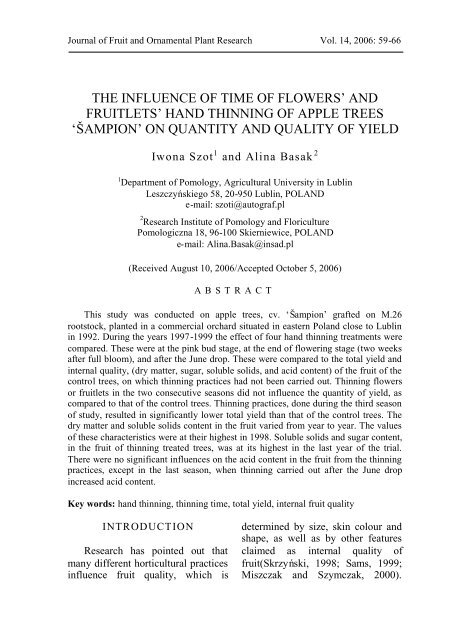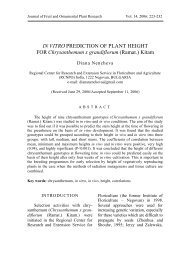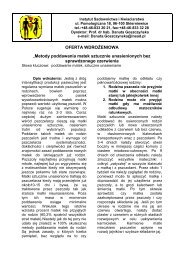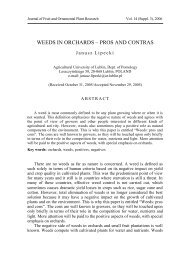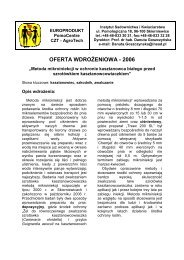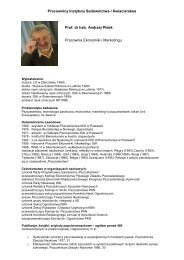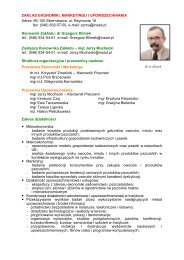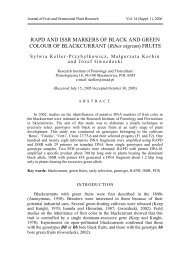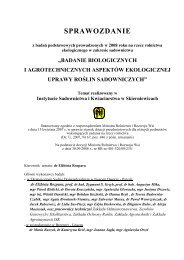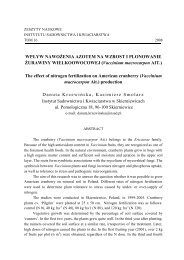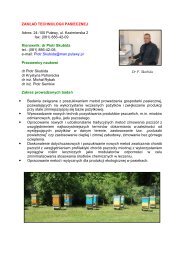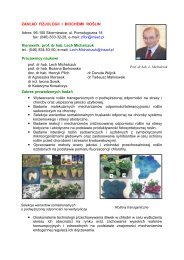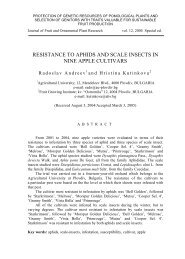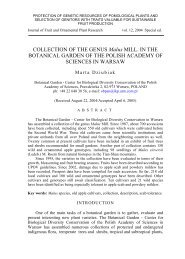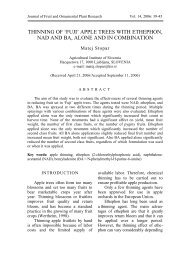and fruitlets' hand thinning of apple trees 'Å¡ampion'
and fruitlets' hand thinning of apple trees 'Å¡ampion'
and fruitlets' hand thinning of apple trees 'Å¡ampion'
Create successful ePaper yourself
Turn your PDF publications into a flip-book with our unique Google optimized e-Paper software.
Journal <strong>of</strong> Fruit <strong>and</strong> Ornamental Plant Research Vol. 14, 2006: 59-66<br />
THE INFLUENCE OF TIME OF FLOWERS’ AND<br />
FRUITLETS’ HAND THINNING OF APPLE TREES<br />
‘ŠAMPION’ ON QUANTITY AND QUALITY OF YIELD<br />
Iwona Szot 1 <strong>and</strong> Alina Basak 2<br />
1 Department <strong>of</strong> Pomology, Agricultural University in Lublin<br />
Leszczyńskiego 58, 20-950 Lublin, POLAND<br />
e-mail: szoti@autograf.pl<br />
2 Research Institute <strong>of</strong> Pomology <strong>and</strong> Floriculture<br />
Pomologiczna 18, 96-100 Skierniewice, POLAND<br />
e-mail: Alina.Basak@insad.pl<br />
(Received August 10, 2006/Accepted October 5, 2006)<br />
A B S T R A C T<br />
This study was conducted on <strong>apple</strong> <strong>trees</strong>, cv. ‘Šampion’ grafted on M.26<br />
rootstock, planted in a commercial orchard situated in eastern Pol<strong>and</strong> close to Lublin<br />
in 1992. During the years 1997-1999 the effect <strong>of</strong> four h<strong>and</strong> <strong>thinning</strong> treatments were<br />
compared. These were at the pink bud stage, at the end <strong>of</strong> flowering stage (two weeks<br />
after full bloom), <strong>and</strong> after the June drop. These were compared to the total yield <strong>and</strong><br />
internal quality, (dry matter, sugar, soluble solids, <strong>and</strong> acid content) <strong>of</strong> the fruit <strong>of</strong> the<br />
control <strong>trees</strong>, on which <strong>thinning</strong> practices had not been carried out. Thinning flowers<br />
or fruitlets in the two consecutive seasons did not influence the quantity <strong>of</strong> yield, as<br />
compared to that <strong>of</strong> the control <strong>trees</strong>. Thinning practices, done during the third season<br />
<strong>of</strong> study, resulted in significantly lower total yield than that <strong>of</strong> the control <strong>trees</strong>. The<br />
dry matter <strong>and</strong> soluble solids content in the fruit varied from year to year. The values<br />
<strong>of</strong> these characteristics were at their highest in 1998. Soluble solids <strong>and</strong> sugar content,<br />
in the fruit <strong>of</strong> <strong>thinning</strong> treated <strong>trees</strong>, was at its highest in the last year <strong>of</strong> the trial.<br />
There were no significant influences on the acid content in the fruit from the <strong>thinning</strong><br />
practices, except in the last season, when <strong>thinning</strong> carried out after the June drop<br />
increased acid content.<br />
Key words: h<strong>and</strong> <strong>thinning</strong>, <strong>thinning</strong> time, total yield, internal fruit quality<br />
INTRODUCTION<br />
Research has pointed out that<br />
many different horticultural practices<br />
influence fruit quality, which is<br />
determined by size, skin colour <strong>and</strong><br />
shape, as well as by other features<br />
claimed as internal quality <strong>of</strong><br />
fruit(Skrzyński, 1998; Sams, 1999;<br />
Miszczak <strong>and</strong> Szymczak, 2000).
I. Szot <strong>and</strong> A. Basak<br />
The quality <strong>of</strong> fresh fruit changes<br />
during the period between harvest<br />
<strong>and</strong> sale to the consumer. However,<br />
many studies have shown that some<br />
<strong>of</strong> the major attributes which<br />
influence the attractiveness <strong>of</strong> fruit<br />
are flavour, aroma <strong>and</strong> texture. The<br />
<strong>thinning</strong> <strong>of</strong> flowers or fruitlets,<br />
among horticultural practices,<br />
significantly influences the quality <strong>of</strong><br />
yield. Besides regulating the yield in<br />
subsequent vegetative seasons, <strong>thinning</strong><br />
also affects the content <strong>of</strong> dry<br />
matter, soluble solids, sugar <strong>and</strong><br />
flesh firmness. Thinning <strong>of</strong> <strong>apple</strong><br />
flowers or fruit clusters stimulates<br />
cell division <strong>and</strong> cell expansion<br />
within fruit <strong>and</strong> consequently increases<br />
their size at harvest, which<br />
enhances their commercial value<br />
(Sharples, 1968). The aim <strong>of</strong> this<br />
study was to evaluate the effect <strong>of</strong><br />
timing <strong>of</strong> h<strong>and</strong> <strong>thinning</strong> <strong>of</strong> flowers or<br />
fruitlets on the aforementioned fruit<br />
characteristics <strong>of</strong> ‘Šampion’.<br />
MATERIAL AND METHODS<br />
The <strong>trees</strong> were planted in 1992 in<br />
a bed system with a double row<br />
spaced 1 metre apart. The distance<br />
between the beds was 4 metres. The<br />
<strong>trees</strong> were trained as free spindle <strong>of</strong><br />
3.0 metres in height. All the usual<br />
T a b l e 1 . The procedure <strong>of</strong> the experiment was as follows<br />
Symbols <strong>of</strong><br />
treatment<br />
T1<br />
T2<br />
T3<br />
T4<br />
T5<br />
cultural practices were carried out in<br />
accordance with st<strong>and</strong>ard commercial<br />
orchard procedures. The orchard<br />
floor consisted <strong>of</strong> 150 cm wide<br />
herbicide strips along the tree rows<br />
with mowed grass alleyways between.<br />
Thinning was administered to<br />
50% <strong>of</strong> the total flower clusters at the<br />
pink bud stage <strong>and</strong> at the end <strong>of</strong> the<br />
flowering stage (two weeks after full<br />
bloom). After the June drop the <strong>trees</strong><br />
were thinned to one fruitlet a cluster,<br />
with a spacing <strong>of</strong> about 20 cm<br />
between fruiting clusters (Tab. 1).<br />
Trees without any <strong>thinning</strong> treatment<br />
were left as control <strong>trees</strong>. The fruit<br />
were harvested when the starch index<br />
was within 4-5. To determine the<br />
internal quality <strong>of</strong> the <strong>apple</strong>s, 75 fruit<br />
from each treatment were sampled at<br />
harvest <strong>and</strong> analyzed for dry matter,<br />
soluble solids, sugar <strong>and</strong> acid content.<br />
The chemical measurement samples<br />
were taken individually from every<br />
replicate. The dry weight percentage<br />
was estimated indirectly by determining<br />
the loss <strong>of</strong> moisture. The percentage<br />
<strong>of</strong> soluble solid content, in<br />
the juice squeezed from fresh <strong>apple</strong><br />
flesh, was determined by measuring<br />
refraction index with Abbe’s refractometer,<br />
at 22°C. The reducing<br />
sugar's percentage was determined<br />
by the Luft-Schoorl method.<br />
Time <strong>of</strong> <strong>thinning</strong><br />
Pink bud stage: the removal <strong>of</strong> 50% <strong>of</strong> the flower clusters<br />
End <strong>of</strong> flowering: the removal <strong>of</strong> 50% <strong>of</strong> the flower clusters<br />
Two weeks after full bloom: the removal <strong>of</strong> 50% <strong>of</strong> the fruit clusters<br />
After the June drop: 1 fruitlet left per cluster with 20 cm spacing<br />
between clusters<br />
Control – no <strong>thinning</strong><br />
60<br />
J. Fruit Ornam. Plant Res. vol. 14, 2006: 59-66
…fruitlets’ h<strong>and</strong> <strong>thinning</strong> <strong>of</strong> <strong>apple</strong> <strong>trees</strong> ‘Šampion’….<br />
The acidity was measured in the<br />
homo-genate. The solution was<br />
titrated with 0.1 n NaOH to a pH <strong>of</strong><br />
8.1; – this value being accepted as<br />
the neutrality level. The results are<br />
given in percentage values calculated<br />
into malic acid.<br />
A split block design was used,<br />
with three replicates <strong>of</strong> eight <strong>trees</strong><br />
per experimental unit.<br />
The data were statistically collated<br />
using the analysis <strong>of</strong> variance. Tukey’s<br />
multiple range test was used for<br />
means separation at a significance<br />
level <strong>of</strong> 5%.<br />
RESULTS AND DISCUSSION<br />
The quality <strong>of</strong> fruit is expressed<br />
by their size <strong>and</strong> other senoric<br />
attributes such as skin colour, texture,<br />
flovour <strong>and</strong> aroma (Płocharski, 1996).<br />
The degree <strong>of</strong> sweetness <strong>and</strong> tastiness<br />
are affected by the total content <strong>of</strong>,<br />
<strong>and</strong> proportions between, the soluble<br />
solids (especially sugars <strong>and</strong> acids).<br />
One <strong>of</strong> the main aims <strong>of</strong> <strong>thinning</strong> is<br />
to improve the quality <strong>of</strong> fruit, which<br />
greatly depends on crop load. In the<br />
first year <strong>of</strong> this study (1997), the<br />
yield <strong>of</strong> the thinned <strong>trees</strong> did not<br />
differ from that <strong>of</strong> the control ones<br />
(Tab. 2). The <strong>trees</strong> chosen for this<br />
experiment were characterized by the<br />
similarities in their flowering intensity.<br />
The lack <strong>of</strong> differences between<br />
the treatments may be as a result <strong>of</strong><br />
a more intensive natural drop <strong>of</strong><br />
fruitlets from the control <strong>trees</strong>.<br />
Whereas the flowers left after<br />
<strong>thinning</strong> developed into strong fruit,<br />
which in the greater amount remained<br />
up until their harvest. The drop is<br />
always the result <strong>of</strong> strong<br />
competition between fruit (Magein,<br />
1989). Some researchers have stated<br />
that fruit set increased at the higher<br />
source strength, <strong>and</strong> decreased at the<br />
large sink strength (Marcelis <strong>and</strong><br />
Hauvelink, 1999). In 1998, the<br />
subsequent year <strong>of</strong> the study, the<br />
beneficial effects <strong>of</strong> the previous<br />
year's <strong>thinning</strong> on the intensity <strong>of</strong><br />
current year bloom <strong>and</strong> cropping<br />
were observed. The highest yield <strong>of</strong><br />
28.8 kg per tree resulted from the T1<br />
treatment, <strong>and</strong> was significantly<br />
higher than that <strong>of</strong> the control <strong>trees</strong>.<br />
The later terms <strong>of</strong> fruit <strong>thinning</strong> did<br />
not have a significant affect on the<br />
quantity <strong>of</strong> yield, as compared to that<br />
<strong>of</strong> the control <strong>trees</strong>. One <strong>of</strong> the first<br />
who pointed to the possibility <strong>of</strong> tree<br />
yielding regulations by flower<br />
<strong>thinning</strong>, was Crow (1920). He found<br />
that in <strong>apple</strong> <strong>trees</strong> <strong>of</strong> the ‘Wealthy’<br />
<strong>and</strong> ’Duchess <strong>of</strong> Oldenburg’ cultivars,<br />
only <strong>thinning</strong> practices performed<br />
before full bloom promoted fruit<br />
bud initiation. The present explanation<br />
<strong>of</strong> this being that gibberellins,<br />
in the young developing friutlets,<br />
limit the initiation <strong>of</strong> flower buds.<br />
Therefore later in the season, the<br />
gibberellins source decreases <strong>and</strong> has<br />
less influence on the number <strong>of</strong><br />
flower bud sets. In 1999, the last year<br />
<strong>of</strong> the study, each term <strong>of</strong> <strong>thinning</strong><br />
practices produced a significant<br />
decrease in the quantity <strong>of</strong> yield, in<br />
comparison to that <strong>of</strong> the control<br />
<strong>trees</strong>. The smallest yield <strong>of</strong> 20.8 kg<br />
per tree was harvested from <strong>trees</strong><br />
with flowers thinned during the<br />
pink bud stage (T1).<br />
J. Fruit Ornam. Plant Res. vol. 14, 2006: 59-66 61
I. Szot <strong>and</strong> A. Basak<br />
T a b l e 2 . Effect <strong>of</strong> timing <strong>of</strong> <strong>thinning</strong> practices on ‘Šampion’ <strong>apple</strong> <strong>trees</strong> on<br />
cropping (1997-1999)<br />
Total yield [kg per tree]<br />
Time <strong>of</strong> <strong>thinning</strong><br />
year<br />
1997 1998 1999<br />
T1 Pink bud stage 31.3 ab* 28.8 b 20.8 a<br />
T2 End <strong>of</strong> flowering 32.1 b 22.0 a 30.2 b<br />
T3 Two weeks after full bloom 28.1 a 22.0 a 32.0 b<br />
T4 After the June drop 29.4 ab 17.9 a 31.4 b<br />
T5<br />
Control <strong>trees</strong> without <strong>thinning</strong><br />
practices<br />
29.5 ab 21.1 a 44.2 c<br />
*Means marked with the same letters do not differ significantly at P=0.05 according to Tukey’s multiple<br />
range t-test<br />
T a b l e 3 . Effect <strong>of</strong> timing <strong>of</strong> <strong>thinning</strong> practices on ‘Šampion’ <strong>apple</strong> <strong>trees</strong> on dry<br />
matter content in fruit (1997-1999)<br />
Dry matter content [%]<br />
Time <strong>of</strong> <strong>thinning</strong><br />
year<br />
1997 1998 1999<br />
T1 Pink bud stage 13.72 a* 15.42 ab 15.62 c<br />
T2 End <strong>of</strong> flowering 14.98 b 15.34 a 14.92 bc<br />
T3 Two weeks after full bloom 14.11 ab 15.70 ab 14.09 ab<br />
T4 After the June drop 14.40 ab 16.25 b 14.84 a-c<br />
T5<br />
Control <strong>trees</strong> without <strong>thinning</strong><br />
practices<br />
12.67 a 16.06 ab 13.50 a<br />
*For explanation see Table 2<br />
Some researchers pointed out<br />
that <strong>thinning</strong> practices influence the<br />
internal quality <strong>of</strong> the fruit. Indeed<br />
Sharples (1968), who was studying<br />
the effect <strong>of</strong> different terms <strong>of</strong><br />
<strong>thinning</strong>, stated that fruit from thinned<br />
<strong>trees</strong> had significantly greater dry<br />
matter content. In the first <strong>and</strong> third<br />
year <strong>of</strong> our study, the dry matter<br />
content in fruit from <strong>trees</strong> thinned<br />
with T2 treatment was higher, in<br />
comparison to that <strong>of</strong> the control<br />
ones (Tab. 3), but in the other three<br />
treatments the differences were not<br />
significant. The differences in fruit<br />
dry matter content were not significant<br />
in the 1998 season either.<br />
Johnson (1994), stated that higher<br />
yield was generally associated with<br />
higher dry matter production. However,<br />
results obtained by us in 1999<br />
did not confirm that observation <strong>and</strong><br />
have not since. The greatest fruit dry<br />
matter content was in trials, where<br />
the yield was qualitatively the<br />
poorest. Inversely, the lowest fruit<br />
dry matter content was in the fruit<br />
from heavily yielding control <strong>trees</strong>.<br />
This data confirms the findings <strong>of</strong><br />
Palmer et al. (1991) which stated that<br />
62<br />
J. Fruit Ornam. Plant Res. vol. 14, 2006: 59-66
…fruitlets’ h<strong>and</strong> <strong>thinning</strong> <strong>of</strong> <strong>apple</strong> <strong>trees</strong> ‘Šampion’….<br />
the higher yielding control <strong>trees</strong> had significantly smaller fruit, with lower<br />
T a b l e 4 . Effect <strong>of</strong> timing <strong>of</strong> <strong>thinning</strong> practices on ‘Šampion’ <strong>apple</strong> <strong>trees</strong> on soluble<br />
solids content in fruit (1997-1999)<br />
Soluble solids content [%]<br />
Time <strong>of</strong> <strong>thinning</strong><br />
year<br />
1997 1998 1999<br />
T1 Pink bud stage 10.72 a* 13.03 b 12.18 b<br />
T2 End <strong>of</strong> flowering 10.70 a 12.55 a 11.97 b<br />
T3 Two weeks after full bloom 10.85 a 12.60 ab 11.09 a<br />
T4 After the June drop 10.22 a 13.13 b 11.71 ab<br />
T5<br />
Control <strong>trees</strong> without <strong>thinning</strong><br />
practices<br />
9.34 a 12.75 ab 10.93 a<br />
*For explanation see Table 2<br />
dry matter content. In 1999, Marcelis<br />
<strong>and</strong> Hauvelink found that dry matter<br />
partitioning into fruit could be<br />
explained as a function <strong>of</strong> the sink<br />
strength <strong>of</strong> a given fruit, in relation to<br />
the sink strength <strong>of</strong> other fruit. The<br />
number <strong>of</strong> fruitlets is <strong>of</strong> major<br />
importance as a stimulus for dry<br />
matter partitioning <strong>and</strong> fruit growth.<br />
In 1997 <strong>and</strong> 1998 the differences<br />
in soluble solids content between<br />
fruit from thinned <strong>trees</strong>, or that from<br />
the control <strong>trees</strong>, were not statistically<br />
significant (Tab. 4). In the<br />
first year <strong>of</strong> this study, the <strong>thinning</strong><br />
practices did slightly influence an<br />
increase in the values <strong>of</strong> the<br />
described features, in comparison to<br />
those <strong>of</strong> the control <strong>trees</strong>. In 1998,<br />
following <strong>thinning</strong> in the earliest <strong>and</strong><br />
the final terms (T1 <strong>and</strong> T4), the<br />
soluble solids content within the fruit<br />
slightly improved. Whereas in the<br />
last year <strong>of</strong> the experiment all <strong>of</strong> the<br />
<strong>thinning</strong> practices increased the<br />
soluble solids content, in comparison<br />
to that <strong>of</strong> the control <strong>trees</strong>, only in<br />
combinations T1 <strong>and</strong> T2 were the<br />
differences statistically significant.<br />
The results obtained in the last year<br />
confirm the observations <strong>of</strong> Johnson<br />
(1995). He had studied different terms<br />
<strong>of</strong> <strong>thinning</strong> flowers <strong>and</strong> fruitlets <strong>of</strong> cv.<br />
‘Cox Pippin’s Orange’, <strong>and</strong> stated<br />
that <strong>thinning</strong> in the earliest term, (5<br />
days after full bloom), significantly<br />
increased the soluble solids content,<br />
in comparison to that <strong>of</strong> the control<br />
<strong>trees</strong>. Delaying <strong>thinning</strong> practices<br />
had a weaker effect on the improvement<br />
<strong>of</strong> soluble solids content in<br />
the fruit. The higher soluble solids<br />
content, in the fruit from the early<br />
thinned <strong>trees</strong>, may be a reflection <strong>of</strong><br />
a higher accumulation <strong>of</strong> photosynthates.<br />
In the first year <strong>of</strong> the study only<br />
the fruit from <strong>trees</strong> thinned after the<br />
June drop (T4), had significantly<br />
lower sugar content than the fruit<br />
from all the other treatments. All<br />
other differences were not statistically<br />
significant (Tab. 5). There were<br />
no significant differences between<br />
treatments in the following year<br />
(1998). In the last year <strong>of</strong> the<br />
J. Fruit Ornam. Plant Res. vol. 14, 2006: 59-66 63
I. Szot <strong>and</strong> A. Basak<br />
experiment, fruit from <strong>trees</strong> thinned<br />
at T4, T2 <strong>and</strong> T1 had a higher sugar<br />
content, in comparison to that <strong>of</strong> the<br />
control <strong>trees</strong>.<br />
T a b l e 5 . Effect <strong>of</strong> timing <strong>of</strong> <strong>thinning</strong> practices on ‘Šampion’ <strong>apple</strong> <strong>trees</strong> on sugar content<br />
in fruit (1997-1999)<br />
Sugar content [%]<br />
Time <strong>of</strong> <strong>thinning</strong><br />
year<br />
1997 1998 1999<br />
T1 Pink bud stage 6.30 b* 7.68 a 6.65 bc<br />
T2 End <strong>of</strong> flowering 6.25 b 7.58 a 7.06 c<br />
T3 Two weeks after full bloom 5.86 ab 7.36 a 6.03 ab<br />
T4 After the June drop 5.45 a 7.65 a 7.70 c<br />
T5<br />
Control <strong>trees</strong> without <strong>thinning</strong><br />
practices<br />
6.09 ab 7.09 a 5.24 a<br />
*For explanation see Table 2<br />
T a b l e 6 . Effect <strong>of</strong> timing <strong>of</strong> <strong>thinning</strong> practices on <strong>apple</strong> ‘Šampion’ <strong>trees</strong> on acid<br />
content in fruit (1997-1999)<br />
Acid content [%]<br />
Time <strong>of</strong> <strong>thinning</strong><br />
year<br />
1997 1998 1999<br />
T1 Pink bud stage 0.305 a* 0.323 a 0.308 a<br />
T2 End <strong>of</strong> flowering 0.305 a 0.309 a 0.313 a<br />
T3 Two weeks after full bloom 0.293 a 0.311 a 0.313 a<br />
T4 After the June drop 0.310 a 0.310 a 0.362 b<br />
T5<br />
Control <strong>trees</strong> without <strong>thinning</strong><br />
practices<br />
0.340 a 0.340 a 0.280 a<br />
*For explanation see Table 2<br />
In Kvĺle’s research (1969), the<br />
relative crop was considered to be<br />
a major contributing factor for the<br />
variation, found in the acid content<br />
<strong>of</strong> fruit (Tab. 6). However, in this<br />
study, no effect <strong>of</strong> a reduction in the<br />
number <strong>of</strong> flower or fruitlets, on the<br />
values <strong>of</strong> acid content, was found. In<br />
1997 <strong>and</strong> 1998 there were no<br />
significant differences between the<br />
acid content in fruit from the thinned<br />
<strong>trees</strong> or that <strong>of</strong> the control <strong>trees</strong>.<br />
However, the fruit from the control<br />
<strong>trees</strong> were characterized by a slightly<br />
higher acidity. In 1999 the pattern <strong>of</strong><br />
fruit acidity was quite different. Fruit<br />
from the thinned <strong>trees</strong> had a greater<br />
acid content than those from the<br />
control <strong>trees</strong> (but only in trials T4,<br />
where the differences were statistically<br />
significant).<br />
CONCLUSION<br />
1. The <strong>thinning</strong> <strong>of</strong> flowers <strong>and</strong><br />
fruitlets, in the initial two<br />
vegetative seasons, did not affect<br />
the size <strong>of</strong> the yield, as compared<br />
to that <strong>of</strong> the control <strong>trees</strong>. The<br />
<strong>thinning</strong> practices performed in<br />
64<br />
J. Fruit Ornam. Plant Res. vol. 14, 2006: 59-66
…fruitlets’ h<strong>and</strong> <strong>thinning</strong> <strong>of</strong> <strong>apple</strong> <strong>trees</strong> ‘Šampion’….<br />
the third season <strong>of</strong> study significantly<br />
decreased the yield, in<br />
comparison to that <strong>of</strong> the control<br />
<strong>trees</strong>.<br />
2. Dry matter <strong>and</strong> soluble solids<br />
content in the fruit varied from<br />
year to year <strong>and</strong> were at their<br />
highest in the 1998 season. In<br />
1999 fruit from the control <strong>trees</strong><br />
had the significantly lowest<br />
content <strong>of</strong> dry matter.<br />
3. Thinning treatments conducted in<br />
the last year <strong>of</strong> the experiment<br />
significantly increased the fruit<br />
sugar content, in comparison to<br />
that <strong>of</strong> the control <strong>trees</strong> .<br />
1. Generally there was no influence<br />
on the acid content from the<br />
<strong>thinning</strong> practices, except in<br />
1999, when <strong>thinning</strong> after the<br />
June drop significantly increased<br />
the acid content in the fruit.<br />
REFERENCES<br />
Johnson D.S. 1994. Influence <strong>of</strong> time <strong>of</strong><br />
flower <strong>and</strong> fruit <strong>thinning</strong> on the<br />
firmness <strong>of</strong> ‘Cox’s Orange Pippin’<br />
<strong>apple</strong>s at harvest <strong>and</strong> after storage. J.<br />
HORT. SCI. 69(2): 197-203.<br />
Johnson D.S. 1995. Effect <strong>of</strong> flower <strong>and</strong><br />
fruit <strong>thinning</strong> on the maturity <strong>of</strong><br />
‘Cox’s Orange Pippin’ <strong>apple</strong>s at harvest.<br />
J. HORT. SCI. 70(4): 541-548.<br />
Kvĺle A. 1969. Composition <strong>and</strong> quality<br />
<strong>of</strong> Gravenstein <strong>apple</strong>s, as related to<br />
some environmental factors. ACTA<br />
AGR. SCAN. 19: 230-239.<br />
Magein H. 1989. Growth <strong>and</strong> abscission<br />
dynamics <strong>of</strong> ‘Cox’s Orange Pippin’<br />
<strong>and</strong> ‘Golden Delicious’ <strong>apple</strong> fruit.<br />
J. HORT. SCI. 64: 265-73.<br />
Marcelis L.F.M., Hauvelink E. 1999.<br />
Modelling fruit sets, fruit growth,<br />
<strong>and</strong> dry matter partitioning. ACTA<br />
HORT. 499: 39-50.<br />
Miszczak A., Szymczak J.A. 2000. The<br />
influence <strong>of</strong> harvest date <strong>and</strong> storage<br />
conditions on taste <strong>and</strong> <strong>apple</strong> aroma.<br />
ZESZ. NAUK. INST. SADOW.<br />
KWIAC. 8: 361-369.<br />
Palmer J.W., Cai Y.L., Edjamo Y. 1991.<br />
Effect <strong>of</strong> part-tree <strong>thinning</strong> on<br />
fruiting, vegetative growth <strong>and</strong> leaf<br />
photosynthesis in ‘Cox’s Orange<br />
Pippin’ <strong>apple</strong>s. J. HORT. SCI. 66:<br />
319-325.<br />
Płocharski W. 1996. Wymagania jakościowe<br />
owoców dla przetwórstwa<br />
i zamrażalnictwa. Mat. VI Ogólnop.<br />
Zjazdu Hod. Ros. Ogr., pp. 65-70.<br />
Sams C.E. 1999. Pre-harvest factors<br />
affecting post-harvest texture.<br />
POST. BIOL. AND TECHN. 15:<br />
249-254.<br />
Sharples R.O. 1968. Fruit <strong>thinning</strong><br />
effects on the development <strong>and</strong><br />
storage quality <strong>of</strong> ‘Cox’s Orange<br />
Pippin <strong>apple</strong> fruit. J. HORT. SCI.<br />
43: 359-371.<br />
Skrzyński J. 1998. Zmiany jędrności<br />
i wybranych składników organicznych<br />
jabłek ‘Jonagold’ i ‘Rubin’<br />
po przechowywaniu w chłodni<br />
z ULO przy zróżnicowanych poziomach<br />
tlenu. Mat. Konf. XXXVII<br />
Ogólnop. Konf. Sad., pp. 314-318.<br />
J. Fruit Ornam. Plant Res. vol. 14, 2006: 59-66 65
I. Szot <strong>and</strong> A. Basak<br />
WPŁYW TERMINU RĘCZNEGO PRZERZEDZANIA<br />
KWIATÓW I ZAWIĄZKÓW JABŁONI ODMIANY<br />
‘ŠAMPION’ NA WIELKOŚĆI JAKOŚĆPLONU<br />
Iwona Szot i Alina Basak<br />
S T R E S Z C Z E N I E<br />
W trzech kolejnych latach (1997-1999) porównywano wpływ przerzedzania<br />
ręcznego kwiatów w fazie różowego pąka, w końcu kwitnienia, 2 tygodnie po pełni<br />
kwitnienia lub zawiązków po opadzie świętojańskim w stosunku do kontroli (drzewa<br />
bez żadnych zabiegów przerzedzania) na plon całkowity (kg/drzewo). Doświadczenie<br />
założono na jabłoni odmiany ‘Szampion’ na podkładce M.26, posadzonych w 1992<br />
roku w sadzie produkcyjnym w Świdniku Małym niedaleko Lublina.<br />
Zabieg przerzedzania kwiatów lub zawiązków w dwóch kolejnych sezonach<br />
wegetacyjnych nie wpłynąłistotnie na zmniejszenie wielkości plonu w stosunku do<br />
kontroli. Dopiero przerzedzanie w trzecim sezonie zmniejszyło istotnie plon<br />
w porównaniu z drzewami kontrolnymi. W pierwszych dwóch latach badańnie było<br />
istotnych różnic w zawartości suchej masy, ekstraktu i cukrów w owocach zebranych<br />
z drzew poddanych przerzedzaniu zawiązków w stosunku do kontroli. W trzecim<br />
roku (1999) zanotowano istotne różnice. Prawie wszystkie kombinacje przerzedzania<br />
zwiększyły poziom wymienionych parametrów w stosunku do kontroli. Przerzedzanie<br />
zawiązków owocowych w czerwcu spowodowało istotne zwiększenie zawartości<br />
kwasów w owocach.<br />
Słowa kluczowe: ręczne przerzedzanie, terminy przerzedzania, plon, jakośćowoców<br />
66<br />
J. Fruit Ornam. Plant Res. vol. 14, 2006: 59-66


